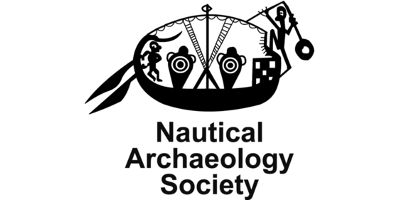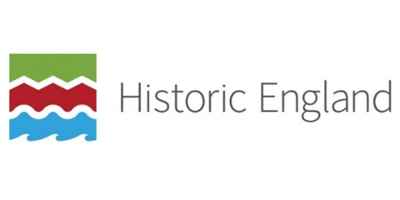Hard Ending: The Post-War Fate of Britain’s D-Day Embarkation Hards
06/05/2020 | Stephen Fisher
Hard Ending: The Post-War Fate of Britain’s D-Day Embarkation Hards
For VE Day, archaeologist and historian Stephen Fisher looks at the fate of some of the Second World War’s most interesting intertidal features – the landing craft embarkation hards built in advance of D-Day.
Although the fighting in Europe officially ended on 8 May 1945, for many in Britain’s armed forces, there was still work to do. The war against Japan was still raging, with no obvious signs that it might end soon. Regular convoys of warships and troopships began sailing towards the Indian Ocean in expectation of further fighting in Far East Asia and the Pacific.
With them went hundred of landing craft of all types, necessary vessels for anticipated amphibious operations on the Malay Peninsula and Japan. At the same time, landing craft were still operating around Europe where the shattered ports weren’t yet ready for traditional shipping, delivering badly needed supplies to the starving and displaced populations of the continent.
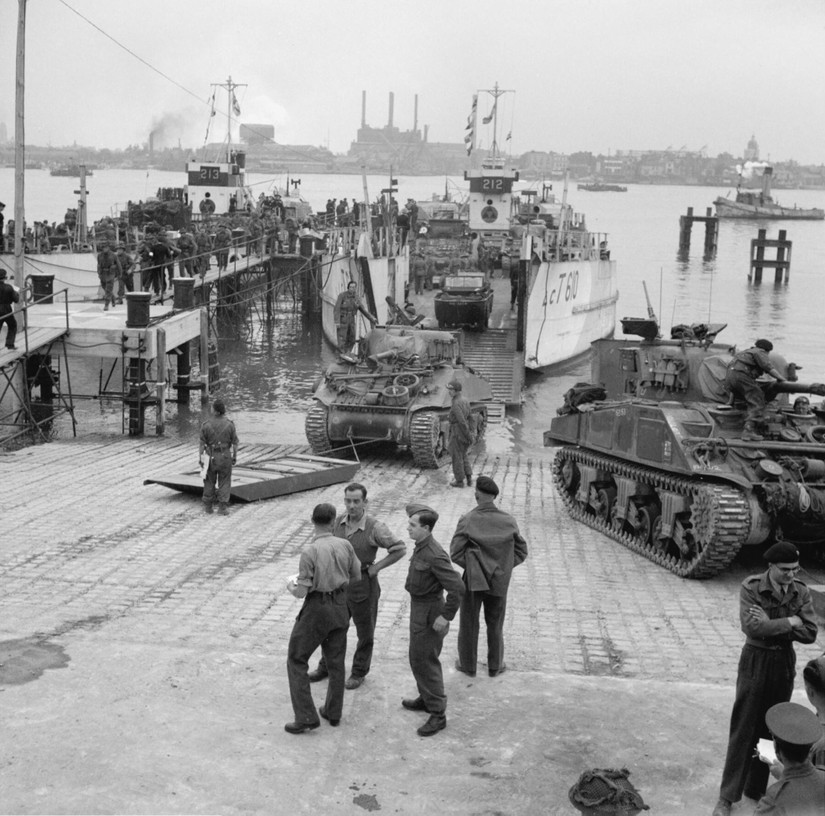
The 13/18 Hussars embark at GF hard in Gosport prior to D-Day. © IWM (H 39000).
While landing craft were still active, the embarkation hards that had been purpose built for them between 1942 and 1944 remained in use as well. Of course, some had seen their peak use a year earlier in the build up to D-Day and hards in the west country in particular, saw little use after the summer of 1944. By the end of that year, with Allied forces sweeping up through Belgium and the Netherlands, most landing craft had moved round to Kent, the Thames Estuary and East Anglia, where they carried on operating from hards in Dover Harbour, Tilbury and Felixstowe.
Nevertheless, military activity was winding down and over the coming years, many hards were taken out of use and handed over to civilian authorities. It was at this point, mainly in the late 1940s and 1950s, that many appear to have been broken up. In some instances this was to clear vitally needed space in busy waterways. On the River Dart, three embarkation hards were in close vicinity to other maritime facilities – the cross-river ferry and the quayside. PC1, 2 and 3 hards are visible in 1947 aerial photographs but by 1954 they have all disappeared from OS maps.
At Southampton, all three hards built between the Old and New Docks were removed. S2 was nearly retained – a few years after the war, the Isle of Wight & South England Royal Mail Steam Packet Co Ltd (who became Red Funnel) purchased LCT 828 and converted her into the passenger and vehicle ferry MV Norris Castle II to operate between Southampton & the Isle of Wight. They originally intended to use S2 hard next to Royal Pier as their main loading jetty in Southampton, but Southampton Harbour Authority thought otherwise and the company were persuaded to use some spare Mulberry Harbour Whales and a Buffer Pontoon instead.
S2 hard was demolished, along with S1 in Mayflower Park and S3 at Town Quay. The piers at S3 had to be removed with explosives and whilst the work was taking place, engineers found the remains of much older post-medieval pilings that had somehow survived the development. Around the corner on the River Itchen, S4 hard was demolished when the quayside was extended. Today, the only visible remains of four D-Day points of landing craft embarkation in the city is a short stretch of concrete road and hardstanding in the corner of Mayflower Park.
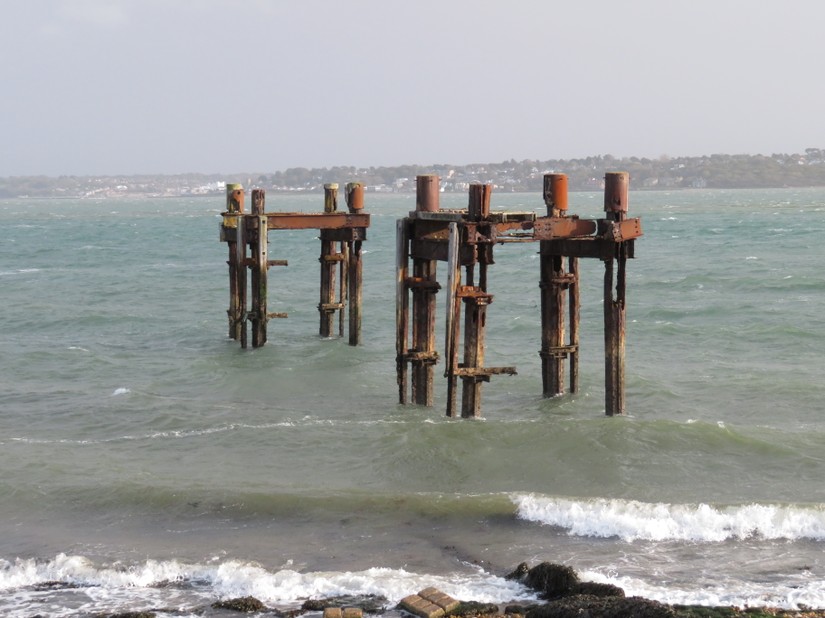
The mooring dolphins at Lepe would appear to be the only surviving dolphins built for a Second World War embarkation hard that still survive today. © Stephen Fisher.
At places around the Solent, other hards were broken up at the same time. At Lepe, Southampton Harbour Authority removed Q2 hard in 1949, possibly to remove the risk of future maintenance costs. As it happens, two of the mooring dolphins were left in place as they were built of metal instead of timber, and it was not thought cost effective to remove them. They might be surprised to find that they still stand even today.
Other hards are less well documented, but the archaeological evidence suggests deliberate deconstruction. At places like NG hard on the Thames at Gravesend, C2 hard at Tidemills near Newhaven and PP1 and PP3 hards at Mount Edgcumbe near Plymouth, the piers have been removed and the concrete beach hardening mats have been deliberately stripped from the intertidal area. At some places they’ve been reused – at PH hard at Helford near Falmouth, the owner of Trebah Gardens received a government grant to remove the wartime infrastructure from the beach. The hardening mats were lifted and are now used as a path through the gardens. Nonetheless the concrete hardstanding and access roads remain, so the beach wasn’t fully returned to its former state.
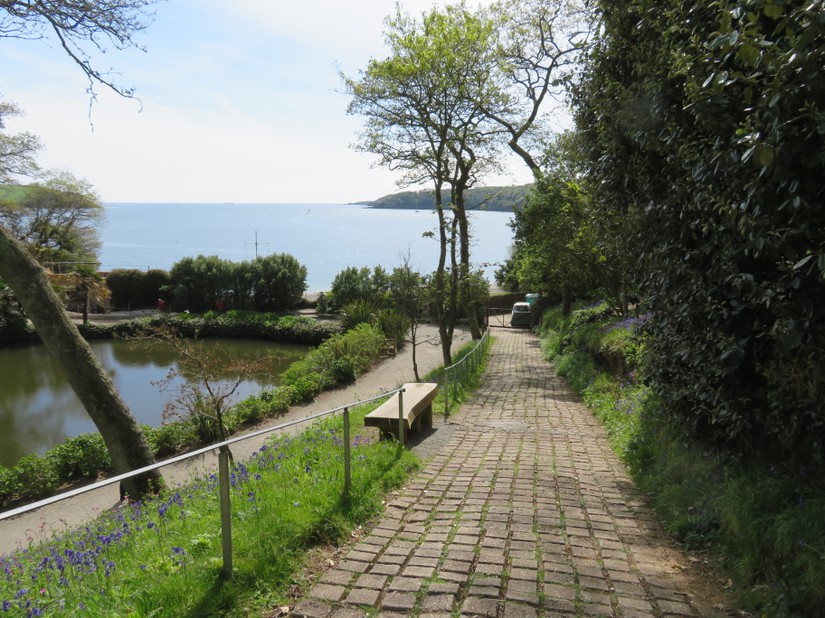
Beach hardening mats repurposed in Trebah Gardens. © Stephen Fisher.
Some hards have been totally removed, leaving no visible trace today. Those at Hythe near Folkestone have been removed in their entirety, with no visible remains of the hardstandings or piers, returning the beaches to their pre-war appearance. At Dover, hards have been built over as the ferry terminal has expanded and at Gosport, GF hard now lies under the foreshore that has moved further into the harbour than its original pre-war limits.
On the other hand, many hards found a post war life of their own. At places like Gosport Hardway in Portsmouth Harbour, Wolverstone on the River Orwell near Ipswich, the Blackwater Estuary in Essex and on the River Medway near Chatham, embarkation hards were retained for use by local boat and yacht clubs. Today many of these survive almost intact, with the concrete hardstanding above the high water mark and the beach hardening mats in the intertidal area still laid out as they were in the 1940s. Even the concrete access roads are still in use to give access to the clubs.
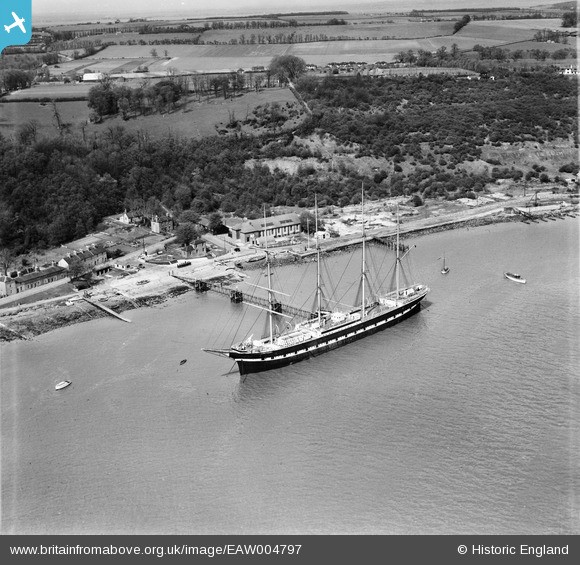
Training Ship Arethusa moored at NU2 hard on the Medway in 1947. Most of this hard still survives today. © Historic England.
Some hards even remain in military use. NU1 hard next to Upnor Castle on the Medway is home to the Royal School of Military Engineering (Riverine Operations section). At Poole, P hard on the site of HMS Turtle is the base for 1 Assault Group Royal Marines and on the Lynher River just outside Plymouth, PS hard at Jupiter point is the base for the Royal Navy’s ‘SeaSense’ training facility.
Those that remain on public beaches today can still teach us a great deal about their construction, and even when they appear to have been totally removed, evidence of them can be found. At Stokes Bay in Gosport little appears to remain of the original access roads, hardstanding and beach hardening mats of G1 to G4 hards, but when the tide is low, large amounts of the ‘chocolate blocks’ can be found. Look back at the car park at the top of the beach and you’ll realise it’s built on top of a concrete base – the original hardstanding of the hard itself, now used as a much more peaceful means of getting into the Solent.
© Stephen Fisher.
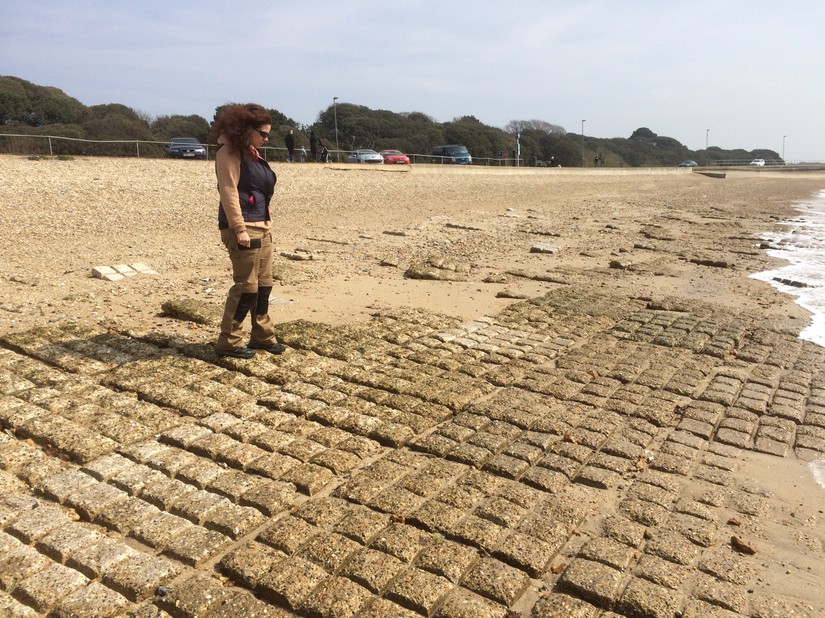
CITiZAN project manager Caroline Barrie-Smith inspects beach hardening mats at Stokes Bay. In the background the concrete base of G1 hard is visible underneath Alverbank West car park. © Stephen Fisher.
You can find out more about D-Day and embarkation hards by following Stephen on Twitter at https://twitter.com/SeaSpitfires.
Remember to follow https://twitter.com/CITiZAN1 for more regular updates on our intertidal fieldwork.





